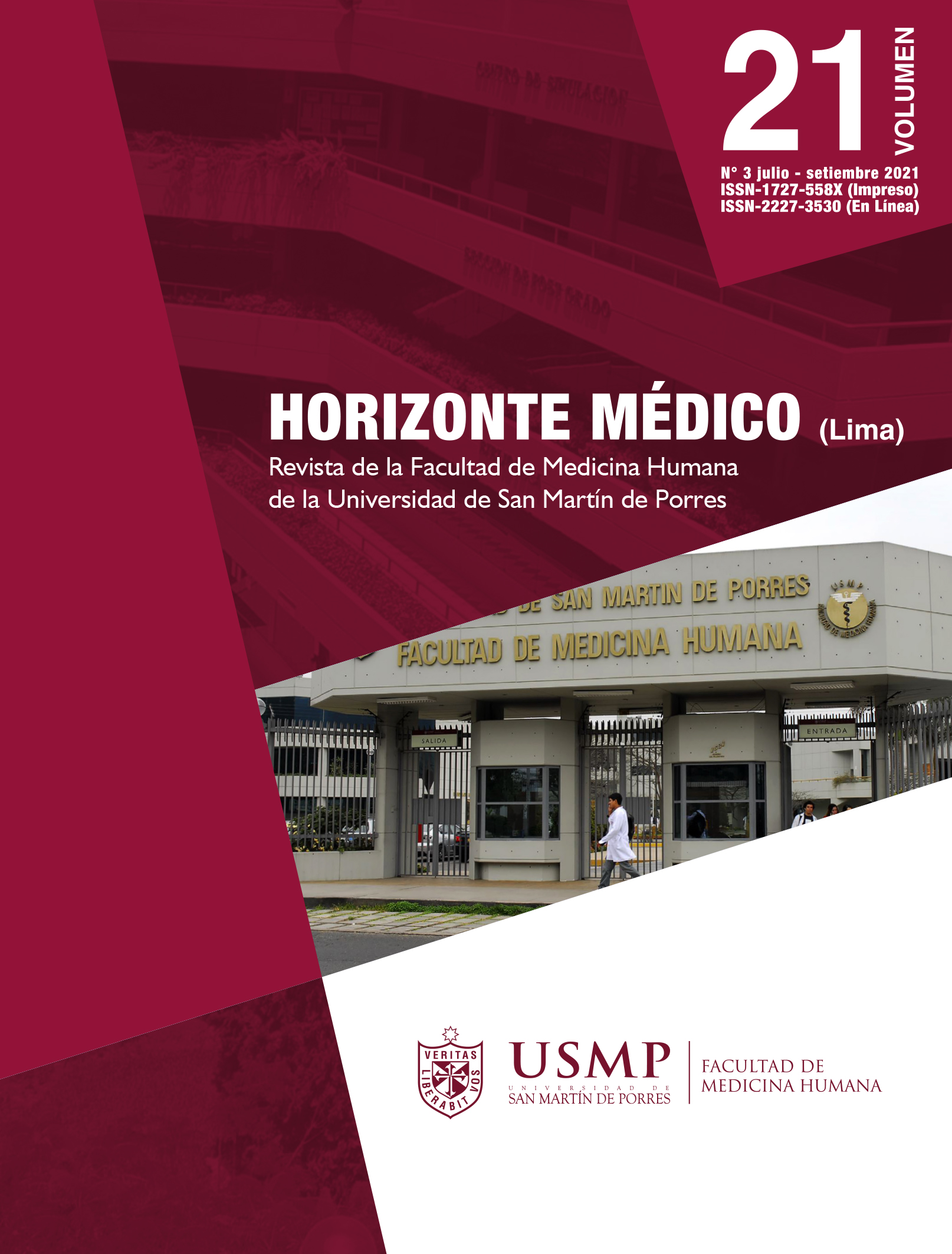Prostate-specific antigen (PSA) related to the anthropometric profile among patients admitted at the Hospital II Huamanga Carlos Tuppia García-Godos, EsSalud. Ayacucho
DOI:
https://doi.org/10.24265/horizmed.2021.v21n3.07Keywords:
Prostate-specific antigen (PSA), Anthropometry, Body mass index (BMI)Abstract
Objective: To determine the association between plasma and mass prostate-specific antigen (PSA) levels and the anthropometric profile, taking into account the risk of prostate pathologies. Materials and methods: A correlational, quantitative, cross-sectional and retrospective study conducted with a sample of 156 medical records of male patients with PSA tests and anthropometric data. Spearman's Rho with a 95 % confidence level was used to analyze the relationship between the variables. Results: The average age of the patients was 67.85 ± 10.83 years and their mean PSA value was 3.57 ± 7.30 ng/mL. Fifteen (15) patients (9.60 %) had a low risk (PSA = 4.1 – 9.90 ng/mL), eight (5.10 %) a medium risk (PSA = 10 – 19.90 ng/mL) and six (3.80 %) a high risk (PSA ≥ 20 ng/mL) of developing prostate pathologies. The mean body mass index (BMI) was 26.37 ± 3.81 kg/m2: 85 patients (54.50 %) were overweight and 18 (11.50 %) were obese. The mean mass PSA was 14.89 ± 30.50 μg, the body surface area (BSA) was 3.93 ± 2.72 m2 and the plasma volume was 4.18 ± 0.21 L. A very low positive correlation was evidenced between plasma PSA and age (rho = 0.184; p = 0.022) and between mass PSA and age (rho = 0.176; p = 0.028). There was a moderate positive association between plasma PSA and BSA (rho = 0.456; p = 0.000) and between mass PSA and BSA (rho = 0.463; p = 0.000). No relationship was found between BMI and PSA. Conclusions: The association between plasma and mass PSA levels and the anthropometric profile was demonstrated, taking into account the risk of prostate pathologies, which increased with BSA and age.
Downloads
References
Armstrong BK, Barry MJ, Frydenberg M, Gardiner RA, Haines I, Carter SM. PSA testing for men at average risk of prostate cancer. Public Health Res Pract. 2017; 27(3): e2731721-6.
Organización Panamericana de la Salud. Expertos regionales discuten enfoques para el tamizaje y detección temprana del cáncer de próstata en las Américas [Internet]. OPS; 2017. Disponible en: https://www.paho.org/hq/index.php?option=com_content&view=article&id=13818:regional-experts-discuss-approaches-for-prostate-cancer-screening-and-early-detection-in-the-americas&Itemid=42459&lang=es
Heidenreich A, Bolla M, Mason MD, Matveev V, Mottet N, Schmid HP, et al. Guía clínica sobre el cáncer de próstata [Internet]. Vol 1. European Association of Urology; 2010. 196 p. Disponible en: https://www.aeu.es/UserFiles/01-GUIA_CLINICA_SOBRE_EL_CANCER_DE_PROSTATA.pdf
Cookson MS, Lowrance W. Guía 2020 del Cáncer de Próstata Avanzado. American Urological Association [Internet]. 2020; 13: 12. Disponible en: https://caunet.org/wp-content/uploads/2020/04/AUAEspanol0520v4.pdf
Robles Fernández I. Identificación de biomarcadores predictivos, pronósticos y de respuesta al tratamiento en cáncer de próstata [Tesis de posgrado]. Granada: Universidad de Granada. Departamento de Medicina Legal, Toxicología y Antropología Física; 2018.
National Cancer Institute. Cáncer de próstata: datos estadísticos sobre el cáncer [Internet]. NIH: USA; 2021. Disponible en: https://seer.cancer.gov/statfacts/html/prost.html
Instituto Nacional de Enfermedades Neoplásicas. Cáncer de próstata es la neoplasia maligna más frecuente en varones [Internet]. INEN: Lima; 2019. Disponible en: https://portal.inen.sld.pe/cancer-de-prostata-es-la-neoplasia-maligna-mas-frecuente-en-varones/
Navarro Cutiño M, Godoy Durán S, Contreras Duverger DM. Utilidad del antígeno prostático específico en la hiperplasia prostática benigna para la detección del cáncer. Arch Hosp Univ «Gen Calixto García». 2018; 6: 50-6.
Allott EH, Hursting SD. Obesity and cancer: mechanistic insights from transdisciplinary studies. Endocr Relat Cancer. 2015; 22(6): R365-86.
López Fontana C, Maselli ME, Pérez Elizalde R, Di Milta N, Corica Alberto P, López Laur JD. La obesidad modifica el antígeno prostático específico en hombres mayores de 45 años de edad. Arch Esp Urol. 2011; 64(1): 35-42.
Messina D, Soto C, Corte C, Pérez Elizalde R, López Laur JD, López Fontana C. Relación entre índice de masa corporal y antígeno prostático específico en varones libres de enfermedad prostática. Actual Nutr. 2013; 14(3): 228-35.
Instituto Nacional del Cáncer. Análisis del antígeno prostático específico (PSA). [Internet]. INC: USA; 2017. Disponible en: https://www.cancer.gov/espanol/tipos/prostata/hoja-informativa-psa
Instituto Nacional de Estadística e Informática. INEI - Perú: Encuesta Demográfica y de Salud Familiar 2018 - Nacional y Regional [Internet]. INEI: Lima; 2018. Disponible en: https://www.inei.gob.pe/media/ MenuRecursivo/publicaciones_digitales/Est/Lib1656/index1.html
Acosta N, Varela R, Mesa JA, Serrano López ML, Cómbita AL, Sanabria-Salas MC. Biomarcadores de pronóstico en pacientes con cáncer de próstata localizado. Rev Colomb Cancerol. 2017; 21(2): 113-25.
Godoy Durán S, Navarro Cutiño M, Contreras Duverger DM. Antígeno Prostático Específico para la detección del cáncer en la Hiperplasia Prostática Benigna. Rev Cub Urol. 2018; 7: e43.
Valiente Morejón W, Junco Sena B, Padrón Vega Y, Ramos Águila YC, Castillo García I. Antígeno prostático específico como predictor del diagnóstico de adenocarcinoma prostático. Rev Finlay. 2015; 5(4): 221-7.
Ballentine Carter H. American Urological Association (AUA) guideline on prostate cancer detection: process and rationale. BJU Int. 2013; 112(5): 543-7.
Eapen RS, Herlemann A, Washington SL, Cooperberg MR. Impact of the United States Preventive Services Task Force «D» recommendation on prostate cancer screening and staging. Curr Opin Urol. 2017; 27(3): 205-9.
Wang K, Chen X, Bird VY, Gerke TA, Manini TM, Prosperi M. Association between Age-Related Reductions in Testosterone and Risk of Prostate Cancer – An Analysis of Patients’ Data with Prostatic Diseases. Int J Cancer. 2017; 141(9): 1783-93.
López Ríos L, Sánchez Montero IR, García Moreno I. Relación entre el marcador tumoral antígeno prostático específico y la mortalidad por cáncer de próstata. CCM. 2017; 21(1): 100-11.
Published
How to Cite
Issue
Section
License
Copyright (c) 2021 Horizonte Médico (Lima)

This work is licensed under a Creative Commons Attribution 4.0 International License.
Horizonte Médico (Lima) (Horiz. Med.) journal’s research outputs are published free of charge and are freely available to download under the open access model, aimed at disseminating works and experiences developed in biomedical and public health areas, both nationally and internationally, and promoting research in the different fields of human medicine. All manuscripts accepted and published in the journal are distributed free of charge under the terms of a Creative Commons license – Attribution 4.0 International (CC BY 4.0).


















